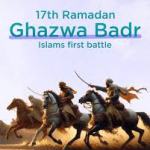The Battle of Badr, fought on the 17th of Ramadan in the second year of the Hijrah (March 624 CE), stands as a cornerstone in Islamic history—a triumph of faith, resilience, and divine favor. This clash near the town of Badr, 130 kilometers southwest of Medina, pitted a modest Muslim force led by Prophet Muhammad (PBUH) against a formidable Quraysh army from Mecca. Outnumbered and under-equipped, the Muslims’ victory reshaped the trajectory of Islam, cementing its place as a rising power in Arabia and offering timeless lessons in courage, unity, and strategic brilliance.
The Prelude to Conflict
Badr’s significance emerged from a confluence of tensions. For years, the Muslims endured persecution in Mecca, prompting their migration to Medina. Yet, the Quraysh persisted in their hostility, conspiring with local tribes to undermine the nascent Muslim community. Divine permission to fight back came through the Quran: “Permission [to fight] has been given to those who are being fought because they were wronged” (22:39). The immediate spark, however, was economic. The Prophet (PBUH) aimed to intercept a lucrative Quraysh trade caravan led by Abu Sufyan, a move to weaken Mecca’s financial lifeline. Alerted to the threat, Abu Sufyan rerouted the caravan and called for reinforcements, escalating the encounter into a full-scale battle.
The stakes were high. Badr’s location, a vital trade hub linking Mecca to the Levant, amplified its strategic value. For the Quraysh, defending their economic interests was paramount; for the Muslims, it was a fight for survival and legitimacy.
The Forces at Play
The odds favored the Quraysh overwhelmingly. Their army boasted over 1,000 warriors, armed with 200 horses, numerous camels, and seasoned commanders like Abu Jahl and Utbah ibn Rabi’ah. In stark contrast, the Muslim force numbered just 313, with only two horses and 70 camels. Many lacked proper weapons, sharing what little they had. Yet, their strength lay not in numbers but in faith and resolve, guided by the Prophet’s (PBUH) leadership.
The Battle Unfolds
The night before the battle, the Prophet (PBUH) prayed fervently, beseeching Allah’s aid. His supplication was answered with a divine promise: “Indeed, I will reinforce you with a thousand angels following one another” (Quran 8:9). This assurance set the stage for an extraordinary victory.
The battle opened with tradition—single combat between champions. Three Muslim stalwarts—Hamza ibn Abdul Muttalib, Ali ibn Abi Talib, and Ubaydah ibn al-Harith—faced Quraysh warriors and emerged victorious, boosting morale. As the armies clashed, the Muslims’ discipline shone. Strategically positioned near water sources, they held a tactical edge. Amid the chaos, divine intervention became evident: angels bolstered their ranks, sowing panic among the Quraysh. Key enemy leaders, including the notorious Abu Jahl, fell, signaling the collapse of Quraysh resistance.
By day’s end, the Muslims triumphed, losing only 14 fighters while the Quraysh suffered 70 deaths and 70 captives. The disparity in losses underscored the battle’s miraculous nature.
A Transformative Aftermath
The victory at Badr reverberated far beyond the battlefield. For the Muslims, it was a divine endorsement of their cause. Confidence soared, and Islam gained converts in Medina and beyond as tribes recognized its growing might. Politically, the Quraysh’s humiliation weakened their prestige, though it fueled their resolve for revenge, setting the stage for future conflicts like the Battle of Uhud.
The Prophet’s (PBUH) treatment of prisoners showcased Islamic mercy. Rather than retribution, he offered leniency—many captives earned freedom by teaching literacy, fostering education in Medina. This act highlighted a blend of justice and compassion that defined early Islamic governance.
Enduring Lessons
Badr’s legacy lies in its profound lessons. First, it proved that faith can defy odds. The Muslims’ trust in Allah and their leader transcended their material deficits. Second, unity and discipline were decisive—their cohesion under the Prophet (PBUH) turned weakness into strength. Third, strategic foresight mattered: securing water sources and leveraging terrain showcased tactical acumen. Finally, divine support, evidenced by angelic aid, reinforced the belief that righteousness prevails with Allah’s backing.
A Historical Milestone
The Battle of Badr was no mere skirmish; it was a turning point that propelled Islam from a persecuted faith to a formidable force. It established Prophet Muhammad (PBUH) as a leader of unparalleled stature, blending spiritual authority with military prowess. For Muslims worldwide, Badr remains a symbol of hope and resilience, its echoes resonating in the annals of history as a testament to the power of conviction over adversity.
XOXO XOXO
In March 624 CE, near the windswept wells of Badr, 313 ill-equipped Muslims faced a Quraysh army three times their size. Led by Prophet Muhammad (PBUH), their victory defied logic—born of faith, unity, and divine aid. This pivotal clash shattered Mecca’s dominance, ignited Islam’s rise, and left an indelible mark on history. A tale of courage and strategy, Badr’s legacy endures as a beacon of resilience against insurmountable challenges.



